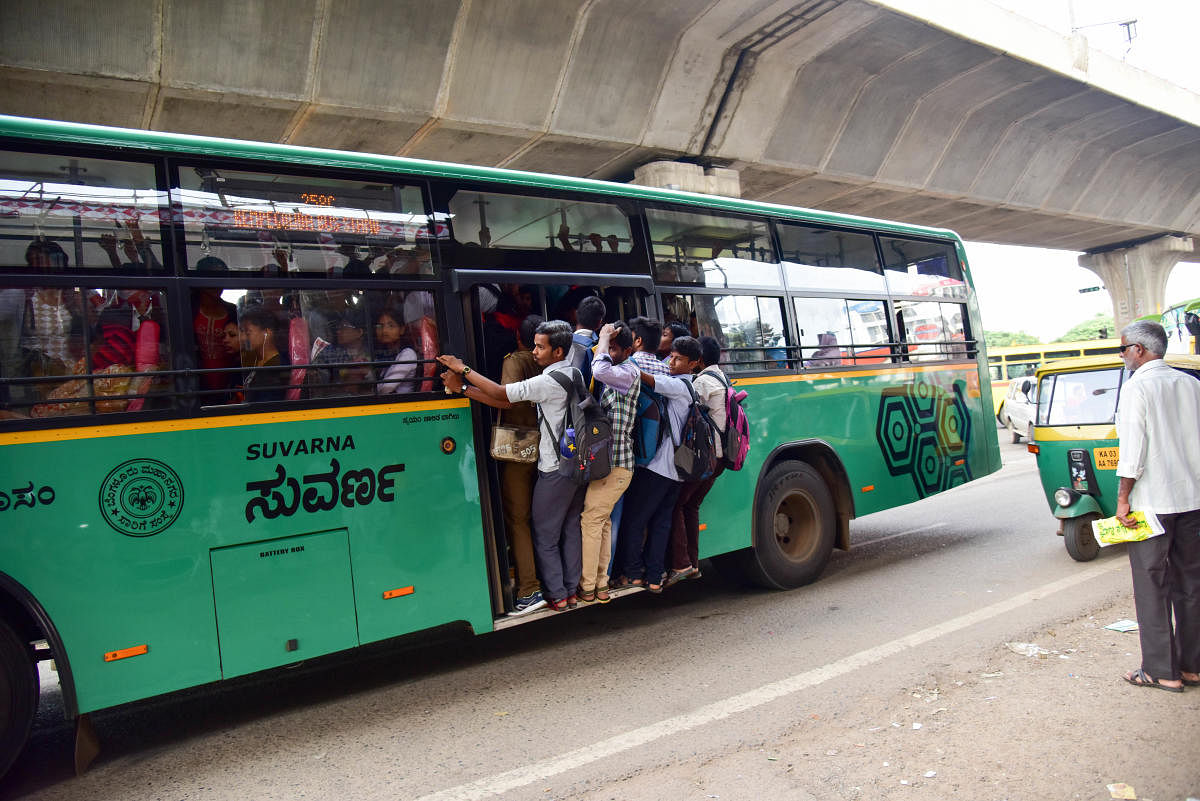Hopelessly trapped in gridlocked roads for hours, as Bengalureans cry out for relief, the only savior in sight is the Bangalore Metropolitan Transport Corporation (BMTC). But this behemoth has only 6,634 buses to address the crying needs of a city with 1.2 crore people. Is this a shortage by design or a glaring proof of messed up priorities?
Low bus numbers have meant fewer trips, lower frequency and vast swathes of thickly populated areas poorly served. So, how do you expect a dramatic shift of thousands from the private cars and motorcycles to public transport? This question, a real no-brainer, ought to have spurred the transport corporation to enhance its fleet. Yet, the numbers have remained static for years. Why?
Road space question
The contention in the official corridors of power banks on a counter-question: Where is the road space for more buses? But there is enough space for hundreds and thousands of personal private vehicles to be registered and let loose on these roads every day. To make it even easier for them, grand elevated corridors are now being built.
The BMTC says it has plans to increase the fleet, even take buses on lease. But probe a bit more, and the answer is clear: The cash flow from the State to procure more buses has reduced to a trickle. “The government is not funding the corporation. So the progress is very slow, and it is very concerning,” notes Shaheen Shasa from the Bengaluru Bus Prayanikara Vedike (BBPV).
Electric, CNG buses
The Corporation’s focus is now more on electric and CNG buses. “This is important. But it should be part of a larger programme of fleet enhancement. An electric bus will cost around Rs 2.4 crore, while regular buses are only Rs 25-30 lakh per vehicle,” Shasa reasons.
BMTC currently runs 70,025 trips with a ridership of 51 lakh. Every bus makes about five to six round trips daily. But the huge crowds seen at bus stops on several under-served stretches of the city are an indication that these numbers are nowhere near meeting Bengaluru's commute needs.
True, BMTC buses are not the only public transport option. But urban mobility experts contend that the alternative, the Namma Metro work is progressing at a glacial pace. Despite widespread citizens campaigns, a truly game-changing suburban rail network for the city has failed to even get to the Special Project Vehicle (SPV) stage.
Route withdrawals
The message is clear: Boosting BMTC fleet strength is a quicker way to promote public transport, at least in the short term. But the Corporation, in a bid to cut its accumulated losses of about Rs 850 crore, has begun to withdraw buses from routes that do not make the anticipated revenues. Long-suffering commuters feel this shortcut to route rationalisation will aggravate their commute woes.
In the period from April to June this year, BMTC reduced about 6,100 full-day bus schedules and 2,250 routes. Is this the way to go? Why not rationalise the fares during peak and off-peak hours?
For instance, office-goers take the Volvo buses plying on the busy Old Airport Road leading to Marathahalli, ITPL, Whitefield and beyond.
But during off-peak hours, this ridership dries up, forcing hundreds of commuters who cannot afford the high fares to wait in vain for the ordinary buses. Their question is this: Why not reduce the Volvo bus fares during off-peak hours so that the fleet need not run virtually empty?
Bus Bhagya Beku
To put this in perspective, consider a pilot programme run by the BMTC after the BusBhagyaBeku campaign by BBPV and Citizens for Bengaluru (CfB). “For two months, the fares of the AC Vajra buses were reduced by 37%. The results showed that the number of bus commuters increased by 42%. The increase in bus patronage clearly gave the message,” recalls Srinivas Alavalli from CfB.
However, the programme was cancelled due to a big rise in diesel prices. “We had two big demands under BusBhagyaBeku: Reduce the fares by half and double the fleet. Conduct an experiment on Outer Ring Road with dedicated lanes. As soon as people realise that bus is faster than car, then they will make the switch.”
The way out
So, what next? Vinay Sreenivasa from BBPV lists the key issues with BMTC that needs immediate attention: “School children with bags discouraged; routes and schedules cut without notice; over-crowded buses; no predictability; over 5,000 bus stops without shelters; and safety issues while crossing road after alighting a bus.”
Accessibility issues for the differently abled and senior citizens are also critical. “Reduction in ordinary buses where AC buses ply; lack of offline grievance redressal system and total lack of services in many revenue layouts, are also big issues.”
Sreenivasa estimates that Bengaluru, with 1.2 crore people, will require at least 14,000 buses. Globally, the norm is 120 buses for every one lakh people. Adding another 8,000 buses would cost Rs 2,400 crore. This is achievable. But to make an impact, the State will have to emphatically shift its priority, from private to public transport.
